The first painting
The first registered painting by Dick Beer (reg. nr. 351) shows a park at Hampstead Heath in dark colours. It is an oil on small wood panel (15 x 20 cm) smartly executed in 1903 at the age of 10 (it is not possible to tell that this is the work of a small boy). At this time young Richard lived in London and did learn the office with his father, the aquarellist and horse painter John Beer.
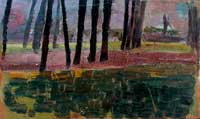
This small canvas was painted by Dick in 1907, at the age of 14.
Horses and races
Dick Beer’s father John (1853-1906) dedicated himself almost exclusively to watercolours with motives representing horsemen and the racing tracks. We see that horses remained a vivid interest with the son. Many times, Dick Beer went with his friend the Italian painter Gabriele Varese to Chantilly and other horse sports places in and around Paris. Compare styles between father and son with the two paintings reproduced beneath.
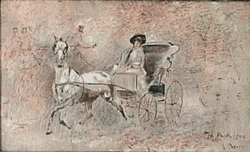
John Beer, Hyde park, 1905
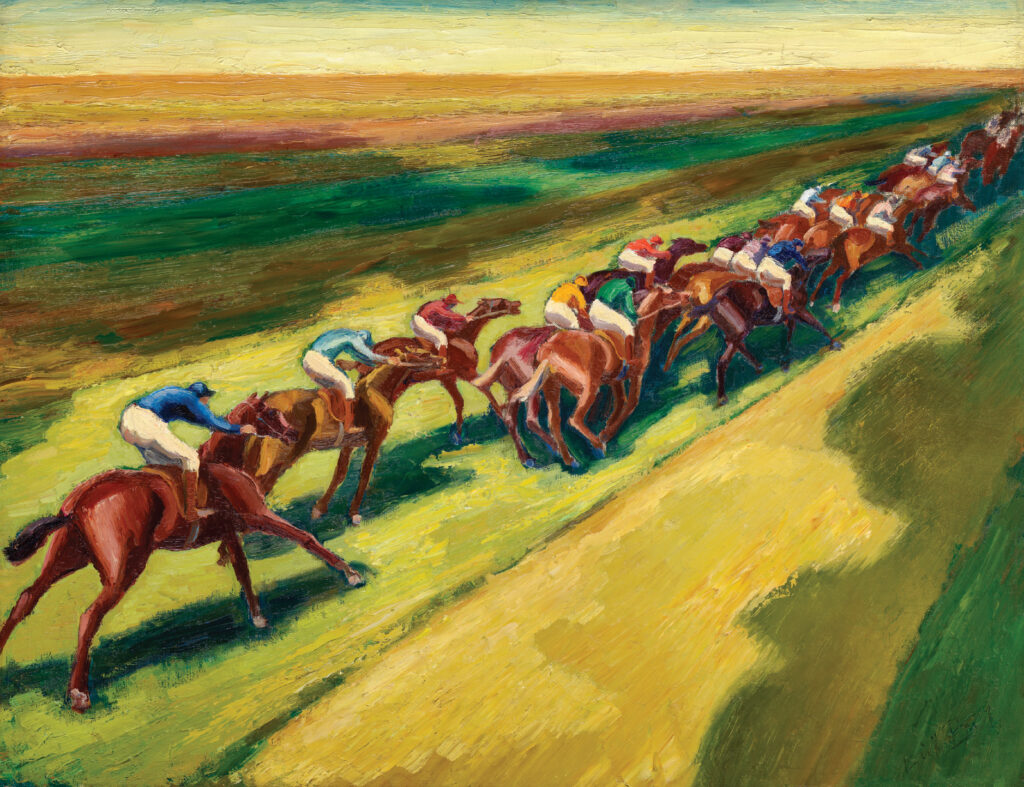
Dick Beer, Horce race, 1925
Where did he paint ?
Dick Beer was a compulsive traveller. Besides Paris and Stockholm, where he spent most of his adult time, the artist painted in many places. In London, still as a child. In Spain: 1914 (different parts) and 1933 (Balearic Islands). Tunisia and Morocco: 1914. Italy: Sicily, Florence, Venice, Milan, Rome (1914, 1920, 1921). In Norway (Lofoten, 1929).
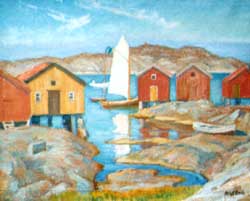
Bohuslän, 1933
In France: Saint Cloud (1912), Pont Aven, Concarneau (1913), Albi (1915, 1920), Rochefort (1915-1916), St Arnoult, Robinson, Fontenay aux Roses (1917), Morgat (Bretagne 1919), Moret sur Loing (1920), Pau and Perpignan (1920), Menton (1921), Saint Valéry en Caux (1923), Dieppe (1925), Corsica (1914, 1919, 1923, 1929, 1937), Quiberon, Auroy (1924), Marseille (1925), Champigny and Chantilly (1926), Cagnes sur Mer, St Tropez, Toulon, Gasny, Avignon, Vaucluse, Champigny, Grez sur Loing (1928), Port Vendres, Martigues, St Chamas, Mariac, Moret, Fontainbleau, Saint Jean de Luz (1929), St Tropez, Plouescat and Finistère (1930), Collioure (1929, 1930, 1932), St Pair (Normandie, 1935), Arles (1938).
In Sweden : Ulriksdal (1910), Visby (1929), Brevik (1933),Trosa (1934), Lurudden (1925, 1932, 1934), Island of Ven (1935), Strängnäs (1936, 1937).
Dick Beer and Christer Strömholm
One of the greatest world photographers, the Swede Christer Strömholm (1918-2002), considered Dick Beer his master in the plastic arts. The two met in Paris, and in February 1938 Christer Strömholm travelled to Arles in Southern France to stay some time with Dick Beer, shortly before the latter died. After this fundamental encounter, Christer Strömholm decided to return to Stockholm and study painting with the well-known artists Otte Sköld and Isaac Grünewald. With his camera, Strömholm portrayed artistic celebrities such as Man Ray and Le Corbusier in Paris. He became famous with his pictures of the transsexuals around Place Blanche in the fifties. In Stockholm, he formed later thousands of students as a dignified professor of photography.
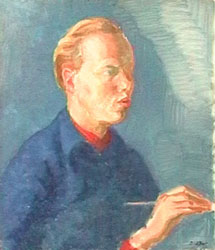
Dick Beer portrayed Christer Strömholm in 1938.
Here he tells about his last time with Dick Beer:
“Arles was a cold town. The Mistral, the Rhône Valley’s specific wind, passed through the streets day and night. In spite of a blue, cloudless sky did the Arles inhabitants enjoy to sit in front of the café’s large stoves and talk. It was here, in the hotel’s bar and restaurant that I saw Dick Beer again. He sat just near the big warm stove with some French-Italian workers and discussed politics. Steaming coffee cups with rum was placed on a table where a cat thirsting for heat had a nap. We entered Dick’s room. It had an entrance directly from the street. There was not much furniture. The easel and the paint box were near the window from which there was a view over a sand square with wind-ravaged willows and the bank protecting against Rhône’s inundations. (…) I stayed fourteen days in Arles and got to know Dick, the painter, pretty well. The mistral went on and Dick worked. He had sketches with horses, an arab soldier was a daily model, there were several paintings ongoing. The day I left he was sick. Dick had caught a cold. Madame, the hotel proprietress who made such a good food, came herself to put the stove to function. Three months later, I read in the paper that Dick was dead.”
The cubist Beer or the futurist Nevinson ?
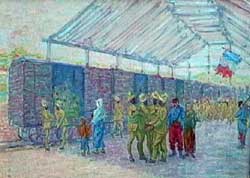
Soldats à la gare , 1915.
In 1979, the Norrköping Museum of Fine Arts held an exhibition where Dick Beer was represented, among others, with a medium-sized oil canvas showing a column of French soldiers advancing, painted in a cubist/expressionist style. Recently, experts think that this Beer painting, which is not signed nor dated, may be a work of the British painter Christopher Nevinson (1889-1946), because of its striking resemblance with another, today quite famous Nevinson picture, “Returning to the trenches”. This latter oil on canvas of medium dimensions (51 x 76 cm) was painted between 1914 and 1915, and belongs to the National gallery of Canada, Ottawa. The first remark is that if Dick painted the Norrköping canvas, then it could not have been before the end of 1917, or more likely in 1918 or 1918. This for a question of style. Before these dates, Beer painted exclusively in a neo- or post-impressionist way. But even later, he did not treat any motives belonging directly to the war/the front (in 1915 though, he painted troops at a railway station in a neo-impressionist style, see reproduction above). Also, the origins of the canvas exhibited in Norrköping were not clear, it had been bought from an estate where the deceased, a Swedish lawyer, had been in close relations with the Beer family. Because of the military theme (Beer was a WWI soldier) and style (rich dark tones, harsh angular shapes of colour, feeling of precipitation) as first criterion, it was thought that the army column painting must have been executed by Dick Beer during his cubist period. But it is very plausible that Beer and Nevinson knew each other. The British painter lived first in Paris as a student between 1912 and 1913, when Dick had just taken up residence there. Nevinson served as an ambulance driver with the Red Cross before being transferred to the Royal Army Medical Corps as a nurse, and before being appointed Official War Artist in 1917. Beer served in the Foreign Legion starting in 1914 and became later an ambulance attendant. Nevinson shared a studio with Modigliani, who was an aquaintance of the Swedish painter. Beer and Nevinson had the English language and London in common, one became a cubist, the other a futurist… At some occasion, the two must have befriended and Beer was given or bought a beautiful canvas which eventually ended up in Sweden. The original “Returning to the trenches” appears also as a dry point sketch, a chalk and a watercolour. It’s an epic picture. A march brings French troops to the front line. But there is nothing enthusiastic or heroic about these soldiers. Later, Nevinson was to give a so grim view of the war’s horrors that some of his pictures were censured.
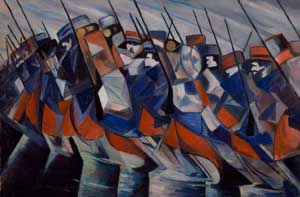
The Norrköping picture thought to be a Nevinson
Exhibitions
Retrospective individual exhibitions after Dick Beer’s death: The Academy of Fine Arts, Stockholm, 1973. Commemorative Exhibitions at Malmö Museum , 1950, Göteborgs Konsthall, 1944 and Swedish-French Art Gallery, Stockholm, 1942.
Beer exhibitions 1913-1937: at Liljewalchs, Valand, Gummessons, Salon de l’Automne, Salon des Indépendants, Rotonde, Galerie Carmine, and many, many others.
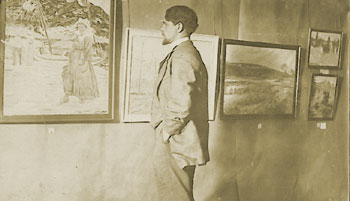
Dick Beer in 1913, at own exhibition
The Falk Simon’s Collection
In March 1955, Gothenburg’s Museum of Art held an exhibition with the remarkable collection of paintings of Mr Falk Simon, one of Sweden’s rare fine-art patrons. Here were shown works by Yves Brayer, Marc Chagall, Albert Marquet, Matisse, Picasso, Pissaro, and, naturally, some 30 Swedish artists. Dick Beer was included in Mr Falk Simon’s collection with four works.
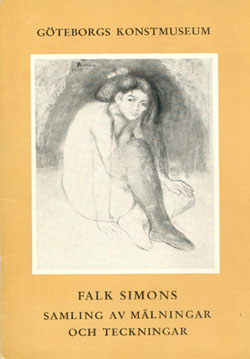
Literature:
“A couple of words regarding an artistic début”, by Axel Gauffin in the review Konst, N°1, pp 5-6, October 1913.
Numerous articles in Swedish, French and European press 1913-1938.
Dick Beer by Dr Ragnar Hoppe, 1942 (monograph).
“With Dick Beer and his friends in Paris”, by Kåge Liefwendal in the Review Vår Konst, Nr 5 Year III, pp 4-8, November 1947.
Svenskt Konstnärslexikon, Tome I, pp 122-123, Alhems 1952.
Rolf Söderberg: 20th Century Art in Sweden, 1961.
Dick Beer by Prof. Sten Karling, in catalogue 1973.
Nordstedt Multimedia: Modernism, 1999 (a CD-Rom collaboration between several museums, illustrated with four major cubist works by Dick Beer (all in museum collections), and which are commented by a contemporary artist.
On Modigliani and the painters in Montparnasse (in French):
http:/perso.club-internet.fr/delpiano/Modigliani.htm
On Foujita, Manuel Ortiz de Zarate, and the golden age of Montparnasse (in English), and also the exhibitions at the Musée de Montparnasse (21, av. du Maine, 75015 Paris): www.metropoleparis.com/1999/403/403foujt.html
See also two monographs published by the Spanish review Arquitectura Viva (Barcelona) on Nordic painting, with two issues : N° 55, 1995 and N° 66, 1997. web site: www.arquitecturaviva.com
Dick Beer is listed in the “AKOUN 2002, La Cote des Peintres”, “L’Annuel des Arts” and the Benezit World Art Reference (Grund Edition, 1999). Dick Beer public sales record : Vue de Tunis 1914, oil/canvas (neo-impressionist period), 73 x 91 cm, London, Christie’s, April 1990, 22,000 GBP (ca 29,500 euros in today’s currency). Medium public sales price1987-2002 : 2,600 euros (www.artprice.com) .